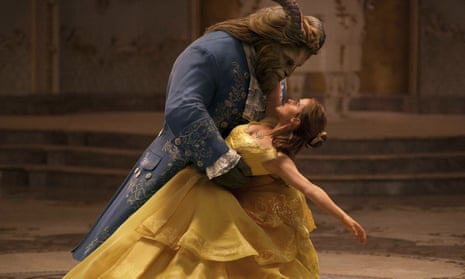If it is anything like as successful as the 1991 animated version, the remake of Disney’s Beauty and the Beast as a live-action movie, opening next week, is likely to be one of the hit films of 2017. I hope so, because I have spent a lifetime obsessing over this particular fairytale.
To begin with, it was not a fairy story but the classical myth of Cupid and Psyche, featuring the first action heroine in literature. According to Apuleius’s The Golden Ass, Psyche’s beauty incites the anger of Venus, who commands her son Cupid to punish her. Instead, he is smitten. Offered up on Apollo’s command as a sacrifice to a monster by her father the king, Psyche is carried off to a beautiful palace where she spends every night in darkness with a lover she promises never to look upon, who she assumes to be the monster.
When she is persuaded to kill him, the candle she smuggles in to the room reveals her lover to be Cupid, who flees, angered by Psyche’s betrayal. The unhappy Psyche must win him back by going on a quest to placate the jealous Venus. She wins through, and Cupid begs, successfully, for her to be made immortal. United, the body and soul produce a child, Pleasure.
Effectively, this is the plot of Beauty and the Beast, written by Gabrielle-Suzanne Barbot de Villeneuve in 1740, and retold countless times under other names, from the Norwegian fairytale “East of the Sun, West of the Moon” to Sarah J Maas’s bestselling 2015 fantasy novel A Court of Thorns and Roses. Originally one of what the psychoanalyst Bruno Bettelheim called “animal groom” stories, intended to reassure virginal brides about sex, Beauty and the Beast has itself been repeatedly transformed.
The original interpretations of it are distasteful. From depictions in antiquity to Canova’s sculptures, artists have tended to present a swooning Psyche in Cupid’s embrace rather than showing her as an active protagonist winning love and divine status in her own right.
Yet Madame de Villeneuve’s version, on which numerous novels and films are based, argues – as Marina Warner says in From the Beast to the Blonde – “for marriages of true minds”. Her Beast must learn to express his heart and mind to become worth loving. It’s a pattern echoed by Samuel Richardson’s Pamela, and even by Pride and Prejudice, in which the proud, rich Mr Darcy must reveal his true goodness to win the witty, bookish Elizabeth Bennet.
Anthony Trollope’s Ayala’s Angel has its impoverished, idealistic heroine reject the honourable Colonel Stubbs because of his bristly red hair and ugly surname, until she is persuaded by events that he is “the real Angel of Light” she has been seeking all along. Even Cocteau’s delicate, dreamlike 1946 film La Belle et la Bête focuses on Belle’s awakening to the Beast’s virtue rather than the Beast experiencing a change.
Angela Carter argued that the story of Beauty and the Beast must be seen “as a literary fairytale”, and her subversive The Tiger’s Bride acknowledged that Beauty needs the Beast quite as much as vice versa. The Disney cartoon, perhaps surprisingly, is the best version yet. Disney’s Beast begins as the incarnation of the spoilt rich kid but love turns him into a brave, generous and self-sacrificing hero. He steals the show even as the feminist, bookish (and rather prim) Belle reforms and loves him.
When I was asked for a novella this year by Quick Reads, the annual initiative run by the Reading Agency, whose mission is to inspire more people to read, Beauty and the Beast seemed the obvious story to use. The Other Side of You has a deprived teenager hiding from a murder. He believes he is outcast as a beast; what changes him is love (and reading). I am currently writing yet another version of the fairytale. Reading is now integral to the fairy story – reflecting, perhaps, how stories themselves give us new versions of ourselves.

Comments (…)
Sign in or create your Guardian account to join the discussion